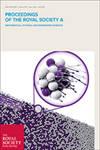m级自催化简单模型中的加速和反应扩散波阵面
Proceedings of the Royal Society of London. Series A. Mathematical and Physical Sciences
Pub Date : 2004-07-08
DOI:10.1098/rspa.2003.1252
引用次数: 2
摘要
我们考虑一个简单的反应扩散系统,该系统模拟发生在m≥1阶自催化反应中的传播前沿。我们得到了有关反应扩散波前和加速波前演化的结果,这些结果将以前在类似标量问题上得到的结果推广到系统中。我们提供了一种替代方法来研究这个系统(通过比较定理),与2000年Malham和Oliver给出的方法(使用加权L2估计)相比,这使得其中的结果得到了相当大的扩展。本文章由计算机程序翻译,如有差异,请以英文原文为准。
Acceleration and reaction–diffusion wavefronts in a simple model for mth-order autocatalysis
We consider a simple reaction–diffusion system that models propagating fronts occurring in autocatalytic reactions of order m≥ 1. We obtain results concerning the evolution of reaction–diffusion wavefronts and accelerating wavefronts, which extend to systems those results which have been previously established for an analogous scalar problem. We provide an alternative approach to studying this system (via comparison theorems) to that given by Malham & Oliver in 2000 (using weighted L2 estimates), which enables a considerable extension of the results therein.
求助全文
通过发布文献求助,成功后即可免费获取论文全文。
去求助
来源期刊
自引率
0.00%
发文量
0
期刊介绍:
Proceedings A publishes articles across the chemical, computational, Earth, engineering, mathematical, and physical sciences. The articles published are high-quality, original, fundamental articles of interest to a wide range of scientists, and often have long citation half-lives. As well as established disciplines, we encourage emerging and interdisciplinary areas.

 求助内容:
求助内容: 应助结果提醒方式:
应助结果提醒方式:


